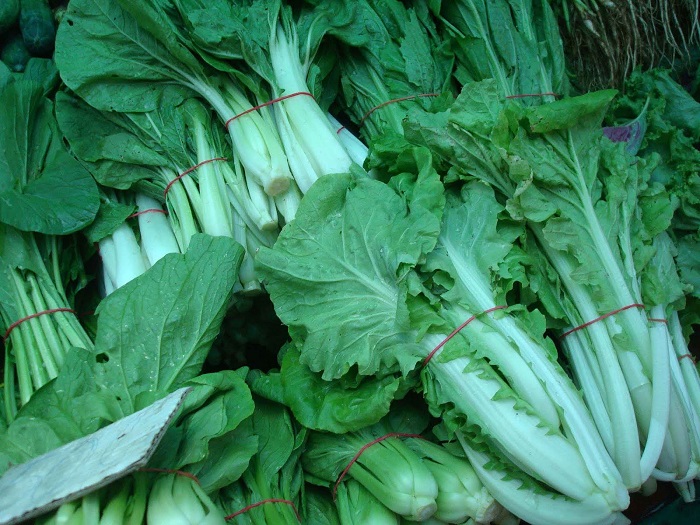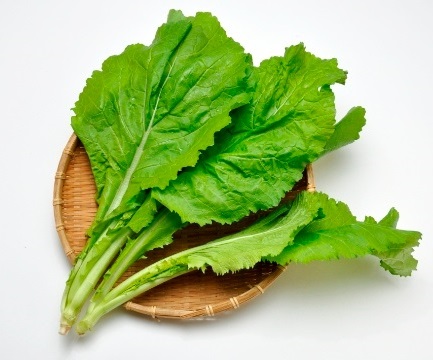Main Name: Mustard Green
Biological Name: Brassica juncea
Names in other Languages: Mostaza (Spanish), Moutarde (French), Sarson ka sag (Hindi), Kadugu ilai (Tamil), Kadugu ila (Malayalam), Ava akulu (Telugu), Rai Ni Bhaji (Gujarati), Sorisa sag (Bengali), Mohari-chi pan (Marathi), Sarson-da-sag (Punjabi), Sarson ka sag (Urdu)
Biological Name: Brassica juncea
Names in other Languages: Mostaza (Spanish), Moutarde (French), Sarson ka sag (Hindi), Kadugu ilai (Tamil), Kadugu ila (Malayalam), Ava akulu (Telugu), Rai Ni Bhaji (Gujarati), Sorisa sag (Bengali), Mohari-chi pan (Marathi), Sarson-da-sag (Punjabi), Sarson ka sag (Urdu)
Salad is the norm of the day. Everyone loves eating healthy and therefore, green leafy vegetables are the best resort. While health is a priority, wouldn’t you love it if your salad was tasty too? Mustard green or the green leaves of the mustard plant help you achieve that. Widely used around the world as a garnishing item, mustard green is preferred by most people for the peppery taste that it lends to any cuisine it is used in. Again, it is not only about the taste but also the beauty of mustard greens that we love so much! While the standard mustard green is emerald green in color, there are dark red and dark purple varieties of the leaf also. Moreover, the lacy and crumpled texture of mustard green adds to the beautiful look of the dish in which it is used. Mustard green, though grown during the cooler climate between December and April, is available in world markets throughout the year. So what are you waiting for? Go and purchase mustard greens today to add that zing of taste to your food and tang of nutrition to your health.
History
Mustard greens have been cultivated and consumed for more than 5000 years now. The first instance of using mustard plants in food can be traced back to the Himalayan regions in and around India. Gradually, the cultivation of the leafy plant spread to different parts of the world as people got accustomed to the pungent flavor of mustard green in their food. Nowadays, mustard green is used in cuisines all over the world, from China to South America. In fact, most of the greens used in foods today are, in reality, the leaves of the mustard plant. Though the Asian countries, comprising India, China, Japan and Nepal, still remain the leading producers of mustard greens, the United States has also started a planned cultivation of the green leaf.
Mustard greens have been cultivated and consumed for more than 5000 years now. The first instance of using mustard plants in food can be traced back to the Himalayan regions in and around India. Gradually, the cultivation of the leafy plant spread to different parts of the world as people got accustomed to the pungent flavor of mustard green in their food. Nowadays, mustard green is used in cuisines all over the world, from China to South America. In fact, most of the greens used in foods today are, in reality, the leaves of the mustard plant. Though the Asian countries, comprising India, China, Japan and Nepal, still remain the leading producers of mustard greens, the United States has also started a planned cultivation of the green leaf.

http://shugo62.blogspot.in/
Health Benefits of Mustard Greens
- Mustard green is known for its detoxification qualities. The sulfur-containing nutrients, phytonutrients and glucosinolates, present in mustard greens help to activate the detoxification enzymes in the human body and also regulate their activities. The detox support is directly related to the risk of acquiring cancers of the bladder, breast, colon, lung, prostate and ovarian. No detoxification in our bodies means that cells will eventually become cancerous.
- Mustard green is also one of the best known antioxidants available in the market. The antioxidant support given by mustard green helps in reducing the risk of oxidative stress in the body cells.
- Mustard green is also known for its anti-inflammatory benefits which help in building the messaging molecules in the body.
- The anti-inflammatory qualities of mustard greens assist in the prevention of several cardiovascular diseases, like heart attacks, ischemic heart diseases, and atherosclerosis.
- Regular consumption of mustard greens is beneficial for lowering the amount of cholesterol in the human blood; thus, leading to a healthy heart. Consuming steamed mustard leaves increases the rate of cholesterol lowering ability, thereby preventing unwanted inflammation that can otherwise cause problems for blood vessels and blood circulation, leading heart attack and ischemic heart disease.
- With many vitamins and minerals present in mustard greens, they promote proper functioning of the immune system and other bodily processes, regulate digestive processes, develop bones and other ligaments connecting the bones, and monitoring the bowels and digestive tract.
- The presence of vitamin E in mustard greens in significant amounts is excellent for taking care of skin and hair by giving you healthy skin and lustrous, strong hair.
- Mustard greens have considerable value in treating a number of disorders, like gout, sciatica, menopause symptoms, neuralgia, asthma, bronchitis, pneumonia, bruises, tendonitis, flu, common cold, eruptive sores and boils.
Mustard Greens Nutrition FactsAmount: 1 cup
Total Weight: 145 g
Total Weight: 145 g
| Nutrients | Amount |
| Basic Components | |
| Proteins | 3.6 g |
| Water | 131.7 g |
| Ash | 2 g |
| Calories | |
| Total Calories | 29 |
| Calories From Carbohydrate | 18 |
| Calories From Fat | 3.3 |
| Calories From Protein | 8.8 |
| Carbohydrates | |
| Total Carbohydrates | 5 g |
| Dietary Fiber | 4.8 g |
| Sugar | 2.3 g |
| Fats & Fatty Acids | |
| Total Fat | 392 mg |
| Saturated Fat | 20 mg |
| Monounsaturated Fat | 180 mg |
| Polyunsaturated Fat | 74 mg |
| Omega-3 Fatty Acids | 35 mg |
| Omega-6 Fatty Acids | 39 mg |
| Vitamins | |
| Vitamin A | 7492 IU |
| Vitamin C | 37 mg |
| Vitamin E | 2.9 mg |
| Vitamin K | 721 mcg |
| Thiamin | 70 mcg |
| Riboflavin | 89 mcg |
| Niacin | 456 mcg |
| Vitamin B6 | 190 mcg |
| Folate | 201 mcg |
| Pantothenic Acid | 28 mcg |
| Choline | 0.6 mg |
| Minerals | |
| Calcium | 169 mg |
| Iron | 1.9 mg |
| Magnesium | 22 mg |
| Phosphorus | 44 mg |
| Potassium | 247 mg |
| Sodium | 42 mg |
| Zinc | 334 mcg |
| Copper | 97 mcg |
| Manganese | 493 mcg |
| Selenium | 1 mcg |

http://en.okinawa2go.jp/u/gourmet/1g8p1vfie4or4x
How many calories in mustard greens (per 100 gm)
Mustard greens have about 20 calories per 100 gm of weight.
Mustard greens have about 20 calories per 100 gm of weight.
How to Buy Mustard Greens
- Always try to purchase green colored mustard greens instead of opting for the red or purple colored leaves.
- Make sure that the mustard greens you have purchased are fresh and crisp.
- The green color of mustard greens should be lively. Avoid buying mustard leaves which have yellow or brown spots on the surface.
Mustard Green Storage Tips
- Do not store freshly purchased mustard greens for more than 3 or 4 days in the refrigerator.
- Keep your mustard greens inside a plastic bag before placing it in the refrigerator. Make sure that all the air from the plastic bag has been removed before storing the mustard greens.

